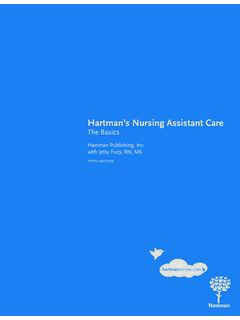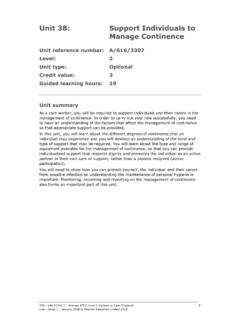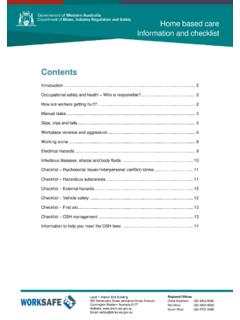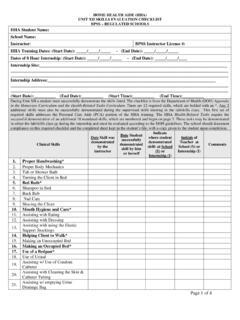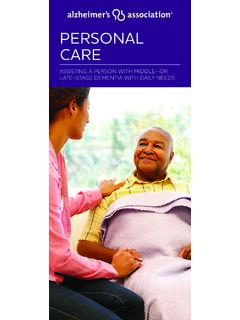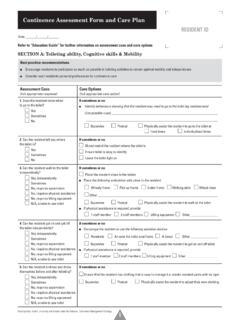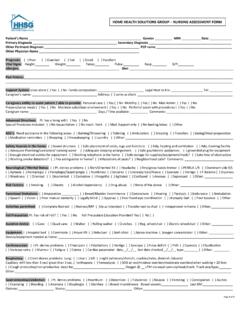Transcription of Unit 37: Support Individuals to Meet Personal Care Needs
1 978 1 446 95316 7 Pearson BTEC Level 2 Diploma in care (England) Unit Issue 1 January 2018 Pearson Education Limited 2018 1 Unit 37: Support Individuals to meet Personal care Needs Unit reference number: M/616/3269 Level: 2 Unit type: Optional Credit value: 2 Guided learning hours: 16 Unit summary The role of a care worker is to ensure that the appropriate level of Support is given to users of services in relation to their Personal care Needs . These Needs include using toilet facilities, maintaining Personal hygiene and managing Personal appearance. Maintaining the individual s comfort, respect and dignity is essential, along with applying standards of hygiene and infection-control precautions. In this unit, you will learn why people may need Support with Personal care and how best to provide it in a way that respects dignity and promotes active participation.
2 You will show how you can protect Individuals from possible infections so an understanding of hygiene is important. You will need to display appropriate sensitivity towards Individuals and respect their privacy. In order to monitor Personal care functions in line with workplace procedures and healthcare requirements, you will be required to update all necessary records. 978 1 446 95316 7 Pearson BTEC Level 2 Diploma in care (England) Unit Issue 1 January 2018 Pearson Education Limited 2018 2 Learning outcomes and assessment criteria To pass this unit, the learner Needs to demonstrate that they can meet all the learning outcomes for the unit. The assessment criteria outline the requirements the learner is expected to meet to achieve the unit. Learning outcomes Assessment criteria 1 Be able to work with Individuals to identify their Needs and preferences in relation to Personal care Encourage the individual to communicate their Needs , preferences and Personal beliefs affecting their Personal care Establish the level and type of Support and individual Needs for Personal care Agree with the individual how privacy will be maintained during Personal care 2 Be able to provide Support for Personal care Obtain valid consent for activities Support the individual to understand the reasons for hygiene and safety precautions Use protective equipment.
3 Protective clothing and hygiene techniques to minimise the risk of infection Explain how to report concerns about the safety and hygiene of equipment or facilities used for Personal care Describe ways to ensure the individual can summon help when alone during Personal care Ensure safe disposal of waste materials 3 Be able to Support Individuals to use the toilet 3. 1 Provide Support for the individual to use toilet facilities in ways that respect dignity Support the individual to make themselves clean and tidy after using toilet facilities Support the individual to wash their hands after using the toilet 978 1 446 95316 7 Pearson BTEC Level 2 Diploma in care (England) Unit Issue 1 January 2018 Pearson Education Limited 2018 3 Learning outcomes Assessment criteria 4 Be able to Support Individuals to maintain Personal hygiene Ensure room and water temperatures meet individual Needs and preferences for washing, bathing and mouth care Ensure toiletries, materials and equipment are within reach of the individual Provide Support to carry out Personal hygiene activities in ways that maintain comfort, respect dignity and promote active participation 5 Be able to Support Individuals to manage their Personal appearance Provide Support to enable the individual to manage their Personal appearance in ways that respect dignity and promote active participation Encourage the individual to keep their clothing and Personal care items clean.
4 Safe and secure 6 Be able to monitor and report on Support for Personal care Seek feedback from the individual and others on how well Support for Personal care meets the individual s Needs and preferences Monitor Personal care functions and activities in line with agreed ways Record and report on an individual s Personal care in line with agreed ways 978 1 446 95316 7 Pearson BTEC Level 2 Diploma in care (England) Unit Issue 1 January 2018 Pearson Education Limited 2018 4 Content What Needs to be learned Learning outcome 1: Be able to work with Individuals to identify their Needs and preferences in relation to Personal care Agreed ways of working Includes policies and procedures where they exist. Referencing to and updating individual s care plan. Identifying care Needs Individual-someone requiring care or Support ; it will usually mean the person or people supported by the learner.
5 Personal care : o use of toilet facilities, toilet, commode, bedpan, urinal o maintaining Personal hygiene, hair care , nail care , shaving o attending to Personal appearance, skin care , use of cosmetics, use of prostheses and orthoses. Preferences and Needs , religious, cultural and Personal beliefs and values, specific care requirements, Personal Support / care plan. Encouragement Methods, offering alternatives, providing guidance, repeating information. Level and type of Support Independent, assisted or full Support . Use of appropriate equipment and aids, sock frame, tights aid, non-slip mats, handles. Maintaining privacy Ways of ensuring dignity and privacy, knocking before entering room. Involvement of key people/others. Learning outcome 2: Be able to provide Support for Personal care Obtaining valid consent Must be in line with agreed UK country requirements.
6 Verbal and non-verbal cues. Capacity to give consent. Reasons for hygiene Spread of infections. Promotes self-esteem. Use of appropriate Personal protective equipment and hygiene techniques, and safe disposal Legal requirements. Standard precautions for infection control and hygiene, hand washing. Protective clothing, disposable gloves and aprons. Sharing toiletries. Staff hygiene. Workplace procedures to prevent contamination, use of yellow bags, yellow sharps box, red bags with inner dissolvable lining. 978 1 446 95316 7 Pearson BTEC Level 2 Diploma in care (England) Unit Issue 1 January 2018 Pearson Education Limited 2018 5 What Needs to be learned Reporting concerns Legal requirement. Workplace procedures. Safety of Individuals . Summoning help Electric call system, call bell, call sensor mat.
7 Hand bell. Verbal and non-verbal cues. Learning outcome 3: Be able to Support Individuals to use the toilet Promoting dignity and respect Adapted clothing, elasticated waistbands, Velcro fastenings, easy wear clothing. Specialist equipment, commode, bedpan, urinal, bidet. Odour control. Maintain privacy. Making clean and tidy Personal Needs and requirements, use of running water, feminine wipes, appropriate incontinence pads. Availability of facilities. Recommended method for hand-washing Recommended method for handwashing following the World Health Organization s 11-step recommended procedure. Learning outcome 4: Be able to Support Individuals to maintain Personal hygiene Supporting maintenance of Personal hygiene Personal hygiene, hands, body, hair and teeth.
8 Offer choice to individual, shower/bath, soap or shower gel, product choice. Appropriate environment, no drafts, dry floors, non-slip shower mat, suitably lit. Appropriate temperature, water, air temperature. Easily accessible equipment, toiletries and materials. Maintain respect and dignity, checking if individual is happy for care worker to remain in room, turning around to respect privacy. Active participation Way of working that recognises an individual s right to participate in the activities and relationships of everyday life as independently as possible. Individual is regarded as an active partner in their own care or Support , rather than as a passive recipient. 978 1 446 95316 7 Pearson BTEC Level 2 Diploma in care (England) Unit Issue 1 January 2018 Pearson Education Limited 2018 6 What Needs to be learned Learning outcome 5: Be able to Support Individuals to manage their Personal appearance Supporting with Personal appearance Offer choice, choice of clothes, hairstyle.
9 Aspects of Personal appearance, hair, nails, shaving, dress. Professional Support , chiropodist, hairdresser. Individual preferences and established routines. Safety, security and cleanliness Labelling of Personal possessions. Secure storage of any valuable items. Allocated Personal space. Safe and timely disposal. Correct working order. Keeping areas tidy with items stored away. Appropriate cleaning techniques, for combs, razors, clothes. Aids to maintain cleanliness, apron/bib for mealtimes to protect clothing. Learning outcome 6: Be able to monitor and report on Support for Personal care Feedback Formal and informal feedback from Individuals . Others, family, carers, friends, specialists, those who use or commission their own health or social care services, healthcare professionals, others who are important to the individual s wellbeing, advocates.
10 Monitoring care functions Agreed ways of working. Recording and reporting Agreed ways of working. 978 1 446 95316 7 Pearson BTEC Level 2 Diploma in care (England) Unit Issue 1 January 2018 Pearson Education Limited 2018 7 Information for tutors Suggested resources Books Aldworth C et al BTEC Nationals Health and Social care student book 2 (Pearson, 2017) ISBN 9780435183776 Ayling P et al Preparing to work in Adult Social care Level 3 (Health and Social care ) (Nelson Thornes Ltd, 2012) ISBN 9781408518137 Nolan Y et al Health and Social care Level 2, 3rd Edition (Heinemann, 2011) ISBN 9780435031947 Walsh M et al Health and Social care Diplomas: Level 2 Diploma Candidate Handbook (Collins Educational, 2011) ISBN 9780007430512 Websites Health and Safety Executive website Gives information on infections at work Provides independent advice about independent living for disabled adults and children, older people, their carers and families National Health Service website Gives information on care and Support and Personal care for cared-for people Social care Institute for Excellence includes a resource called Dignity factors Personal hygiene 978 1 446 95316 7 Pearson BTEC Level 2 Diploma in care (England) Unit Issue 1 January 2018 Pearson Education Limited 2018 8 Assessment This guidance should be read in conjunction with the associated qualification specification for this unit.











